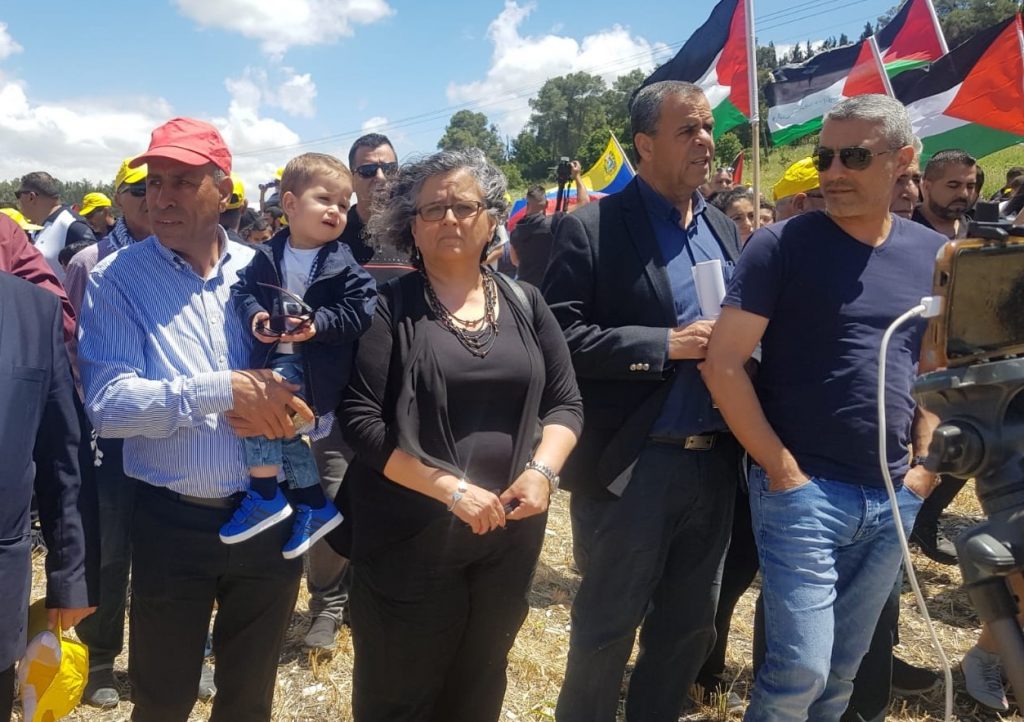Thousands of Arab-Palestinians citizens of Israel and Jewish Israelis commemorated Nakba Day on Thursday, May 9, by marching to the destroyed Palestinian village of Khubbayza in northern Israel. During the first few weeks of the 1948 war, the Haganah, the precursor of the Israel army, raided the village located in the Wadi ‘Ara region which ultimately fell to Israeli forces between May 12 and 14. In June of that year, the village was razed by the Jewish Nation Fund to prevent its residents from ever returning. Today Khubbayza remains unpopulated, surrounded by cultivated lands, pastures and the National Park Ramot Menache.

Hadash Secretary General Mansour Dahamshe (first from left) and MK Aida Touma-Sliman (center) during the Nakba Day march to Khubbayza (Photo: Al Ittihad)
Thursday’s trek was the 22nd time a “March of Return” has been held in conjunction with Israel’s Independence Day. While the official commemoration of Nakba Day is on May 15, the civilian date in 1948 when the British Mandate ended and the State of Israel was unilaterally declared by the Zionist Yishuv, traditionally the march is held annually to coincide with Israel’s Independence Day celebrations (set according to the Hebrew calendar). With each march, a different Palestinian village demolished in 1948 is visited.
“Nakba,” the Arabic word for disaster, is the Palestinian term used to describe the displacement of hundreds of thousands of Palestinians leading up to and following Israel’s founding in May, 1948 and what the Israeli historical narrative calls the “War of Independence.”
Every year, the march is organized by the Association for the Defense of the Rights for the Internally Displaced Persons in Israel and is supported by the Higher Arab Monitoring Committee in Israel. “Internally displaced persons” is the legalistic title given to the descendants of the generation of the Nakba who, even though they are Israeli citizens, are prohibited by law from resettling the sites of the villages that were emptied of their populations during the 1948 war.
As Hadash MK Aida Touma-Sliman has noted, the notorious “demographic threat” that the Israeli establishment likes to obsess on regarding to the increased population of Palestinians in general, and Palestinians with Israeli citizenship in particular, has nothing at all to do with the inhumane barring of the descendants of the Nakba from returning to their ancestral villages, which in large part are still empty. Palestinian citizens of Israel would not increase in number if they were to move from the city or village in which they currently reside to their family’s pre-1948 village. Rather, the issue is one of who owns and controls the land. Because much of this land (having been legislatively given the status of “state land”) is managed by the Jewish Nation Fund or other non-governmental arms and is leased to kibbutzim and moshavim for agricultural use, it is a valuable resource that the regime covets, and is not prepared to relinquish to Palestinians, even when they allegedly enjoy full and equal citizenship.
As one of the four members of the Knesset from Hadash who participated in the march, MK Ofer Cassif succinctly summed up the meaning of the annual procession and the reality it relates to: “We will never live here [in Israel] with real independence and security without a just peace agreement and national equality.”


